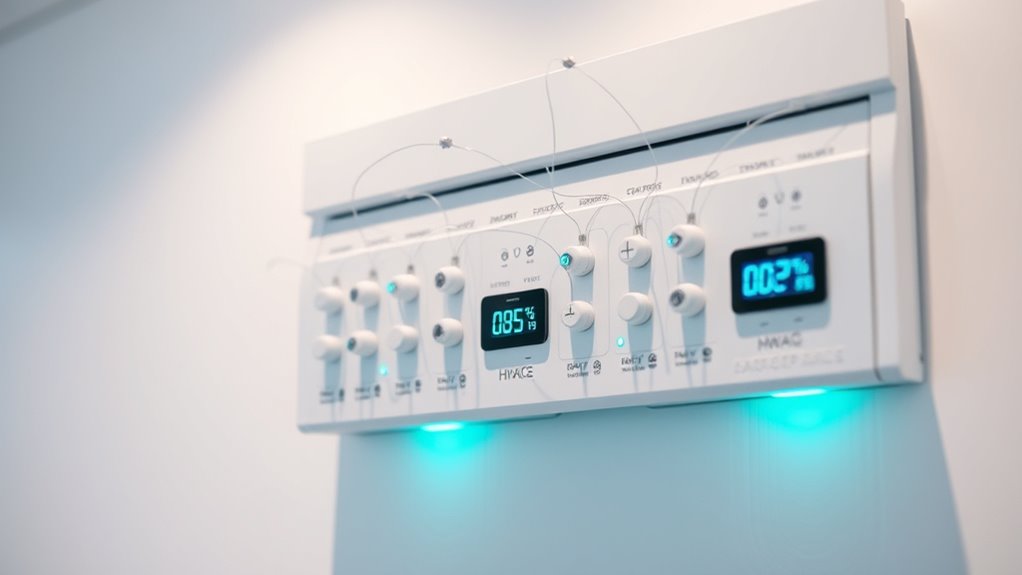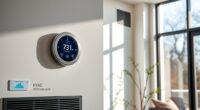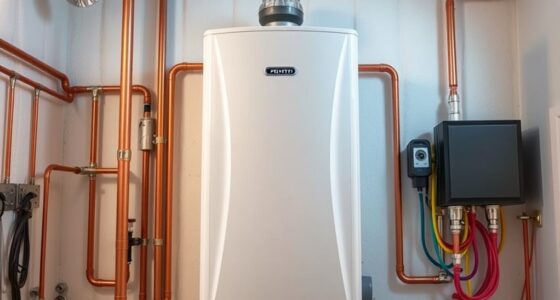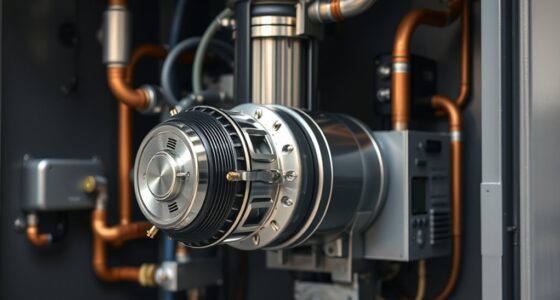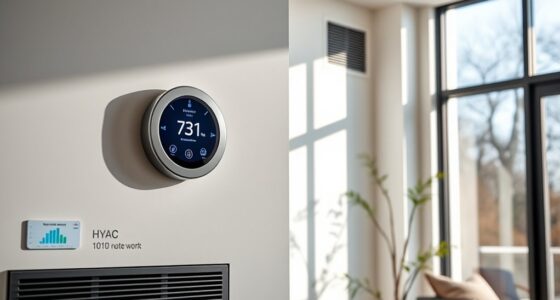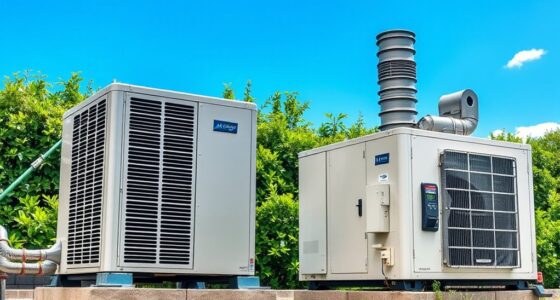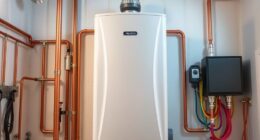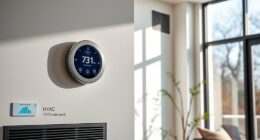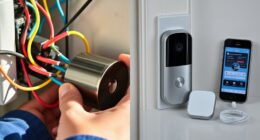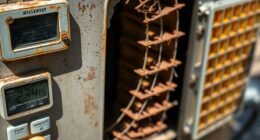IoT sensors collect HVAC performance data by continuously monitoring indoor conditions like temperature, humidity, and air quality, then transmitting this information through Wi-Fi networks. They also track system operations such as airflow and energy use, providing real-time insights. This data helps optimize your HVAC system’s efficiency and comfort. If you’re curious, you’ll discover how this ongoing data collection enables smarter, more responsive climate control in the sections ahead.
Key Takeaways
- IoT sensors measure temperature, humidity, and air quality in real-time to monitor HVAC system performance.
- These sensors connect to Wi-Fi, transmitting data to cloud platforms for analysis and storage.
- They detect occupancy and movement to optimize HVAC operation based on user presence.
- Continuous data collection helps identify system inefficiencies and potential maintenance issues early.
- Sensor data enables automated adjustments for improved energy efficiency and indoor comfort.
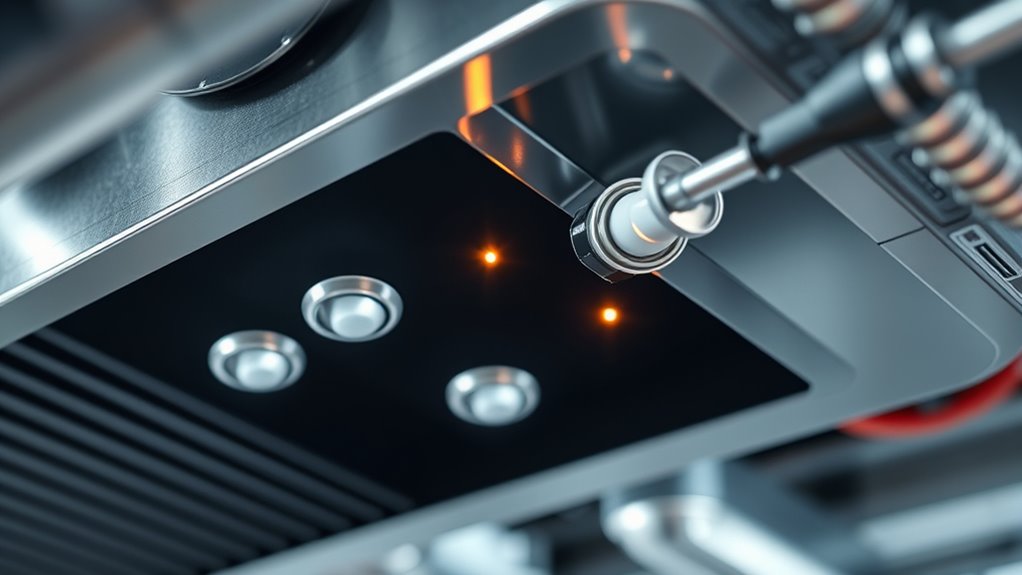
Internet of Things (IoT) sensors are transforming how HVAC systems operate by providing real-time data on temperature, humidity, and air quality. This technological shift allows you to monitor and enhance your heating, ventilation, and air conditioning systems more effectively than ever before. When you install IoT sensors, one of the key components you’ll likely encounter is a smart thermostat. Unlike traditional thermostats, a smart thermostat connects to your Wi-Fi network, enabling remote control and automation based on the data collected by sensors. These devices don’t just turn your HVAC system on and off; they learn your schedule, preferences, and occupancy patterns, adjusting temperatures accordingly. As a result, you experience a more comfortable environment while reducing unnecessary energy consumption.
IoT sensors and smart thermostats optimize HVAC efficiency by learning habits and adjusting temperatures automatically.
The integration of IoT sensors with smart thermostats means you can fine-tune your indoor climate with precision. Instead of maintaining a constant temperature regardless of whether anyone is home, the sensors detect movement and occupancy, allowing your HVAC system to operate only when needed. This targeted approach greatly boosts energy efficiency, helping you save money on utility bills. For example, during work hours or when you’re away, sensors can signal the thermostat to lower heating or cooling, preventing wasteful operation. When you arrive home, the system senses your presence and adjusts to your preferred comfort level automatically. This seamless control is both convenient and cost-effective, emphasizing the importance of energy-efficient practices enabled by IoT technology.
Moreover, IoT sensors continuously monitor air quality levels, providing valuable data that can inform adjustments to ventilation and filtration systems. By maintaining ideal air quality, you not only enhance comfort but also promote healthier indoor environments. The real-time data collected by these sensors helps you identify issues like high humidity or poor air circulation before they escalate into bigger problems. This proactive approach means your HVAC system can respond swiftly, maintaining a healthy living or working space while enhancing energy use. Additionally, wireless connectivity plays a crucial role in ensuring these sensors work seamlessly across your smart home or building infrastructure.
In essence, IoT sensors are the backbone of modern, smart HVAC systems. They empower you to make smarter decisions about your indoor climate, leading to improved energy efficiency and enhanced comfort. With a smart thermostat at the core, these sensors enable your system to operate more intelligently, reducing waste and saving money. As technology advances, expect these systems to become even more intuitive, delivering tailored comfort with minimal effort on your part. The ability to leverage real-time data ensures your HVAC system works efficiently, making your environment more comfortable and your energy consumption more sustainable.
Frequently Asked Questions
How Secure Is the Data Collected by Iot HVAC Sensors?
The data collected by IoT HVAC sensors is generally secure, but it depends on how well you implement security measures. You should guarantee data encryption both during transmission and storage, and set strict access control to limit who can view or modify the data. Regular updates and strong passwords also help protect against vulnerabilities. Staying vigilant and adopting best security practices keeps your HVAC data safer from potential threats.
What Is the Typical Lifespan of an Iot Sensor in HVAC Systems?
Back in the day, sensors were more like trusty compasses, but today, your IoT sensors in HVAC systems typically last about 5 to 10 years. Their durability depends on factors like build quality, environmental exposure, and maintenance. Replacement intervals usually fall within this time frame to guarantee peak performance. Regular checks help catch wear and tear early, so your system stays efficient without unexpected breakdowns.
Can Iot Sensors Detect HVAC System Failures Before They Occur?
Yes, IoT sensors can detect HVAC system failures before they happen by enabling predictive maintenance. They constantly monitor parameters like temperature, pressure, and airflow, identifying patterns that suggest potential issues. Regular sensor calibration guarantees accuracy, helping you catch problems early. This proactive approach minimizes downtime, reduces repair costs, and keeps your HVAC system running smoothly, ultimately improving efficiency and extending its lifespan.
How Do Iot Sensors Handle Data Privacy and Compliance?
They say “trust, but verify,” and with IoT sensors, you should too. You handle data privacy and compliance by implementing robust data encryption and strict user authentication. These measures protect sensitive HVAC data from unauthorized access. Regularly updating security protocols and ensuring compliance with regulations like GDPR or HIPAA helps you keep data safe. Ultimately, proactive security keeps your system reliable and your users’ trust intact.
What Maintenance Is Required for Iot Sensors Over Time?
You need to regularly calibrate your IoT sensors to guarantee accurate HVAC data. Check for sensor drift and recalibrate as needed, usually every 6 to 12 months. Additionally, monitor battery life and replace batteries promptly to prevent data loss. Keep sensors clean and free from dust or debris, and update firmware when updates are available. Proper maintenance keeps your IoT system reliable and efficient over time.
Conclusion
You might think HVAC systems are too complex for simple sensor data to be accurate, but IoT sensors prove otherwise. They continuously monitor performance, revealing patterns and potential issues before they escalate. Some skeptics believe these sensors can’t truly capture the full picture, yet countless cases show they do. Embracing this technology could revolutionize HVAC maintenance, saving energy and money. So, the next time you wonder if sensors really make a difference, remember—they just might be the key to smarter, more efficient systems.
